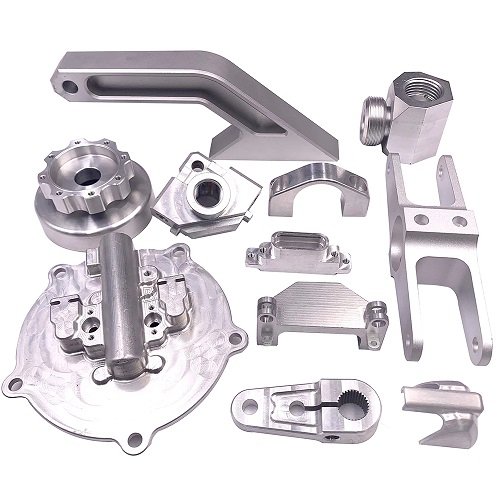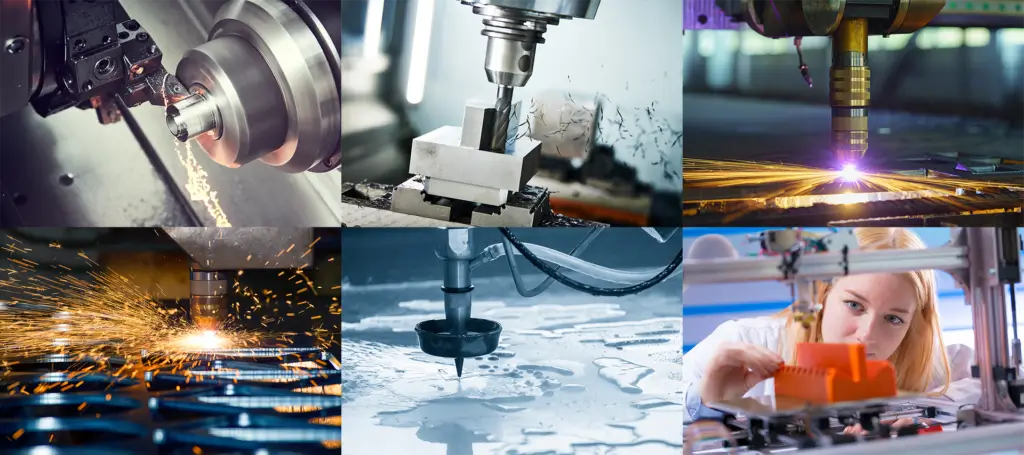Aluminum alloy is an important industrial raw material. Due to its relatively small hardness and large coefficient of thermal expansion, it is prone to deformation in the machining of thin-walled and thin-plate parts. In addition to improving the performance of the tool and the elimination of internal stresses in the material by aging treatment in advance, some means can be taken to minimize the machining deformation of the material from the point of view of the machining process.
For aluminum alloy parts with large machining allowance, in order to create better heat dissipation conditions and reduce thermal deformation, it is necessary to try to avoid too much concentration of heat, and the method that can be taken is symmetrical machining. For example, if there is a 90 mm thick aluminum alloy plate, you need to mill it to 60 mm thick. If milling a good side immediately after the flip over to mill the other side, due to each side is a time to process to the final size, continuous machining allowance is large, will cause heat concentration problems, so that the milling of the aluminum alloy plate flatness can only reach 5 mm. If the symmetric processing method of repeated feed on both sides is adopted so that each side is processed at least twice until the final size is reached, which is conducive to heat dissipation, the flatness can be controlled at 0.3 mm.
Table of Contents

Layered Multiple Machining Method
When there are multiple cavities to be processed on aluminum alloy plate parts, if the method of processing one cavity by one cavity in sequence is adopted, it is easy to make the cavity wall entangled in deformation due to uneven force. The best solution is to take a layered multiple processing method, that is, at the same time, all the cavities are processed, but not a machining is completed, but a number of levels, layer by layer processing to the required size. In this way, the force on the part will be more uniform, and the chance of deformation is smaller.
Proper Selection of Cutting Dosage
Selecting the proper cutting dosage can effectively reduce the cutting force and cutting heat in the cutting process. In the machining process, the cutting dosage will lead to excessive cutting force in one pass, which is very likely to cause deformation of the parts and will have an impact on the rigidity of the machine tool spindle and the durability of the tool. In the cutting amount of each element, the cutting force has the greatest impact on the back draft. It is said that reducing the amount of backdraft is conducive to ensuring that the parts are not deformed, but at the same time will reduce the machining efficiency. High-speed milling of CNC machining can solve this problem. You only need to reduce the amount of backdraft at the same time, correspondingly increase the amount of feed, and improve the speed of the machine tool, you can not only reduce the cutting force but also be able to ensure the machining efficiency.
Improve the Cutting Ability of the Tool
The material and geometric parameters of the tool have an important influence on the cutting force and cutting heat, and the correct selection of the tool is essential to reduce the deformation of the part machining.
① Reasonable selection of tool geometry parameters.
Front angle: under the condition of maintaining the strength of the cutting edge, the front angle is appropriately chosen to be larger. On the one hand, it can grind a sharp edge. On the other hand, it can reduce the cutting deformation, make the chip removal smooth, and then reduce the cutting force and cutting temperature. Never use a negative front-angle tool.
Back angle: the size of the back angle has a direct impact on the wear of the back face and processing surface quality. Cutting thickness is an important condition for selecting the back angle. In rough milling, due to the large feed, heavy cutting load, heat generation, and the requirements of the tool heat dissipation conditions, therefore, the rear angle should be selected smaller. When finishing milling, it is required that the edge is sharp, reduces the friction between the rear cutter face and the machining surface, and reduces the elastic deformation. Therefore, the rear angle should be chosen to be larger.
Helix angle: In order to make milling smooth and reduce milling force, the helix angle should be chosen as large as possible.
Main deflection angle: An appropriate reduction of the main deflection angle can improve the heat dissipation conditions so that the average temperature of the machining area is down.
② Improve the tool structure.
Reduce the number of teeth of the milling cutter and increase the chip space. Due to the aluminum alloy material’s plasticity being large, cutting deformation in the processing is large, and the a need for a larger chip space, so the bottom radius of the chip slot should be larger, and fewer teeth of the milling cutter are good. For example, the milling cutter below φ20mm adopts two teeth, the φ30~60mm milling cutter adopts three teeth to avoid the deformation of thin-walled aluminum alloy parts due to chip blockage.
Precision grinding cutter teeth: the roughness value of the cutting edge of the cutter teeth should be less than Ra=0.4μm. Before using the new cutter, you should use a fine oil stone to gently grind the cutter teeth in front of the back a few times to eliminate the burrs and slight sawtooth pattern left when sharpening the cutter teeth. In this way, not only can reduce the cutting heat and cutting deformation is relatively small.
Strictly control the tool wear standard: tool wear, the workpiece surface roughness value increases, the cutting temperature rises, and the workpiece deformation increases. Therefore, in addition to the selection of wear-resistant tool materials, the tool wear standard should not be greater than 0.2mm. Otherwise, it is easy to produce the accumulation of chip tumors. When cutting, the temperature of the workpiece should generally not exceed 100 ℃ to prevent deformation.
The Order of Tool Settings is Important
Roughing and finishing should use a different order of travel. Roughing requires the fastest cutting speed to remove the excess material on the surface of the blank in the shortest time to form the geometric contour required for finishing. Therefore, the emphasis is on machining efficiency and the pursuit of material removal rate per unit time, you should use reverse milling. While finishing requires higher machining accuracy and surface quality, emphasizing the quality of machining should use smooth milling. As the cutting thickness of the cutter teeth gradually decreases from the maximum to zero in smooth milling, it will greatly reduce the phenomenon of work-hardening and also have a certain degree of inhibition of the deformation of the parts.

Other Measurement Tools
Secondary Compression of Thin-walled Parts
When machining thin-walled aluminum alloy parts, the clamping force is also an important cause of deformation, which is difficult to avoid even if the machining accuracy is improved. In order to reduce the deformation of workpieces due to clamping, it is possible to loosen the pressed parts a little before finishing to the final size, release the compression force so that the parts are free to return to their original shape, and then re-press them slightly. The role of the second compression point is best in the support surface. The clamping force should act in the direction of good rigidity of the workpiece. The size of the compression force to just be able to clamp the workpiece does not loosen shall prevail, which, for the operator’s experience and feel, has high requirements. The deformation of the parts processed in this way is small.
Drilling and Then Milling Method
When machining parts with cavities, if the milling cutter is used to penetrate the parts directly downward, it will cause poor chip removal due to insufficient chip space of the milling cutter, which will lead to the accumulation of a large amount of cutting heat in the parts and expansion and deformation, and may even cause accidents such as chipping and tool breakage. The best way is to first drill after milling. That is, first of all, the size is not smaller than the milling cutter drill hole, and then use the milling cutter into the hole to start milling, which can effectively solve the problems mentioned above.
Conclusion
Deformation control in the machining of aluminum alloy parts is a technical challenge that must be faced in the process of mechanical manufacturing. The continuous optimization of the process means – such as symmetric machining, multi-layer machining, reasonable cutting parameter selection, tool optimization design, scientific tool path and clamping skills enhancement – can not only effectively reduce the machining deformation, improve the dimensional accuracy and surface quality but also extend tool life and improve machining efficiency. Surface quality, but also to extend tool life and improve machining efficiency. Contact us to bring higher stability and reliability to aluminum alloy machining.




